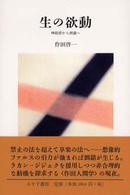- ホーム
- > 洋書
- > ドイツ書
- > Mathematics, Sciences & Technology
- > Medicine & Pharmacy
- > general survey & lexicons
Full Description
This book helps nursing students increase the quality of their clinical reasoning and therefore the quality of care. It teaches students to recognize when clinical reasoning is needed, and what reasoning is involved, and to avoid reasoning errors.







